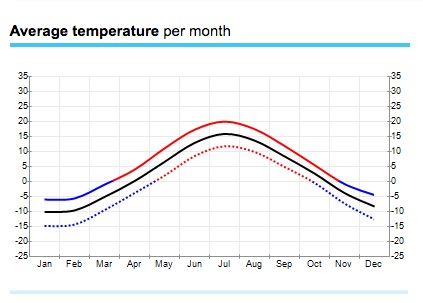Climate and Seasons of Luleå and Swedish Lapland

The climate in Luleå and Swedish Lapland is characterised by cold snowy winters, and due to the Gulf Stream, relatively warm summers. Each year in Swedish Lapland is unique with regard to sunshine, freezing temperatures and precipitation, but the many seasons of Lapland remain very distinct. You can be sure to have the best travel experiences when you keep an open mind and prepare yourself for the prevailing season with the correct clothing and equipment.
In the wintertime the temperatures may fall to minus thirty degrees and the wind chill factor makes it feel even colder. The average temperature for the winter months, January – February, is approximately -13.5°C, and for the summer month of July the average temperature is +14°C. The number of days in Swedish Lapland with snow varies from 175 days to 225 days a year.
The changing of the seasons in Swedish Lapland are dramatic and distinctly noticeable. Lapland’s seasons are spring-winter, spring, summer, autumn, late autumn, and a winter that lasts for around 5 months. Wintertime also includes the twilight period that lasts a few months; a time when there is no real daylight as the sun stays below the horizon above the arctic circle.
Spring
The rays of sunshine glisten off the snow and warm us in the great outdoors. Birds start the day with joyful song and new leaves begin to bud. It is spring, the transitional period from winter to summer.
This is a time when the snow gradually starts to melt and nature awakens to once more display its splendor. It may also even snow in late spring, but summer is on its way, and by Midsummer at the very latest the sun should provide some nice warmth. The temperatures in Lapland in early June can fall a few degrees below zero and it may even snow.
Summer
Summer in Lapland is bright, the time of the nightless night. Night and day the midnight sun stays above the horizon. Actual hot weather (>25°C) days are few and far between in Lapland, as the average temperature for the whole of Lapland varies between 10 to 16 degrees Celsius. Before Midsummer frost can occur in many places in Lapland, so July and its last weeks are the warmest times of the summer. Early summer also has very little precipitation, as rain only starts to increase around August.
During times with no snow, Lapland offers meaningful experiences in the midnight sun, the rugged beauty of the fell highlands and sparkling clear waters. Nature can be experienced by trekking, cycling and horse riding the terrain, or traversing the waterways by canoeing, white water rafting and fishing. In the summertime, visitors should be prepared for mosquitoes, especially if your trip heads for the Lappish wilderness in the heart of nature.
Autumn
As the first night time frost of autumn sets in and the days get shorter, the vegetation starts preparations for the coming winter. The leaves of trees change color from green into vibrant shades of golden yellow and glowing crimson to crown the period of natural color and splendor.
Winter
Winter starts off as dark, bleak and cold in November, but changes into bright and sunny days during springtime at the end of April. The first snowfall may occur in Lapland as early as August – September, but permanent snow cover normally falls in November. Christmas time is the darkest time for Lapland’s twilight period, a time when the sun does not rise above the horizon and there are only a few hours of daylight.
The clean, recently fallen snow puts people in good spirits and facilitates winter activities, such as skiing. During the winter Lapland gets snow from 50 centimetres to over a metre. February is statistically the coldest month of the year, and late February is the time when the twilight period ends.
The sunshine seems to appear from nowhere to once more illuminate the northern skies and spectacularly reflects off the glistening snow. The sunshine and just below zero temperatures of early spring entice people into activities throughout the springtime, as late March is the time with the most snow and the skiing conditions in Lapland are excellent through to mid-May.
During periods of snow, Lapland presents itself as sparkling clean white snowscapes with the glowing northern lights dancing through the dark skies. The silent and snowy nature can be reached in a moment on skis or snowshoes, in a sleigh pulled by huskies or reindeer, or for those after some real speed, alternatives include skiing or snowmobiling.

The climate in Luleå and Swedish Lapland is characterised by cold snowy winters, and due to the Gulf Stream, relatively warm summers. Each year in Swedish Lapland is unique with regard to sunshine, freezing temperatures and precipitation, but the many seasons of Lapland remain very distinct. You can be sure to have the best travel experiences when you keep an open mind and prepare yourself for the prevailing season with the correct clothing and equipment.
In the wintertime the temperatures may fall to minus thirty degrees and the wind chill factor makes it feel even colder. The average temperature for the winter months, January – February, is approximately -13.5°C, and for the summer month of July the average temperature is +14°C. The number of days in Swedish Lapland with snow varies from 175 days to 225 days a year.
The changing of the seasons in Swedish Lapland are dramatic and distinctly noticeable. Lapland’s seasons are spring-winter, spring, summer, autumn, late autumn, and a winter that lasts for around 5 months. Wintertime also includes the twilight period that lasts a few months; a time when there is no real daylight as the sun stays below the horizon above the arctic circle.
Spring
The rays of sunshine glisten off the snow and warm us in the great outdoors. Birds start the day with joyful song and new leaves begin to bud. It is spring, the transitional period from winter to summer.
This is a time when the snow gradually starts to melt and nature awakens to once more display its splendor. It may also even snow in late spring, but summer is on its way, and by Midsummer at the very latest the sun should provide some nice warmth. The temperatures in Lapland in early June can fall a few degrees below zero and it may even snow.
Summer
Summer in Lapland is bright, the time of the nightless night. Night and day the midnight sun stays above the horizon. Actual hot weather (>25°C) days are few and far between in Lapland, as the average temperature for the whole of Lapland varies between 10 to 16 degrees Celsius. Before Midsummer frost can occur in many places in Lapland, so July and its last weeks are the warmest times of the summer. Early summer also has very little precipitation, as rain only starts to increase around August.
During times with no snow, Lapland offers meaningful experiences in the midnight sun, the rugged beauty of the fell highlands and sparkling clear waters. Nature can be experienced by trekking, cycling and horse riding the terrain, or traversing the waterways by canoeing, white water rafting and fishing. In the summertime, visitors should be prepared for mosquitoes, especially if your trip heads for the Lappish wilderness in the heart of nature.
Autumn
As the first night time frost of autumn sets in and the days get shorter, the vegetation starts preparations for the coming winter. The leaves of trees change color from green into vibrant shades of golden yellow and glowing crimson to crown the period of natural color and splendor.
Winter
Winter starts off as dark, bleak and cold in November, but changes into bright and sunny days during springtime at the end of April. The first snowfall may occur in Lapland as early as August – September, but permanent snow cover normally falls in November. Christmas time is the darkest time for Lapland’s twilight period, a time when the sun does not rise above the horizon and there are only a few hours of daylight.
The clean, recently fallen snow puts people in good spirits and facilitates winter activities, such as skiing. During the winter Lapland gets snow from 50 centimetres to over a metre. February is statistically the coldest month of the year, and late February is the time when the twilight period ends.
The sunshine seems to appear from nowhere to once more illuminate the northern skies and spectacularly reflects off the glistening snow. The sunshine and just below zero temperatures of early spring entice people into activities throughout the springtime, as late March is the time with the most snow and the skiing conditions in Lapland are excellent through to mid-May.
During periods of snow, Lapland presents itself as sparkling clean white snowscapes with the glowing northern lights dancing through the dark skies. The silent and snowy nature can be reached in a moment on skis or snowshoes, in a sleigh pulled by huskies or reindeer, or for those after some real speed, alternatives include skiing or snowmobiling.
